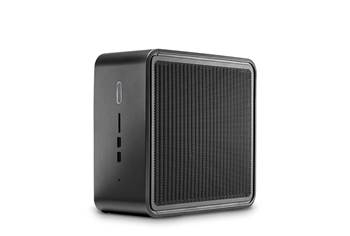There are few computing technologies as versatile as Intel’s NUC. Standing for, ‘Next Unit of Computing,’ these diminutive devices come in a variety of variants to provide solutions for all kinds of computational demand. Whether you need mild electronic brains to operate industrial applications, digital signage and standard office computers or if you need serious hardware to power hardcore workstations and even gaming rigs, there’s an Intel NUC that’s got you covered.
NUCs are also an integrator’s dream. They can be sold as barebones units or as preconfigured systems that enable a faster time to market at lower cost. They offer flexibility to build custom solutions without the R&D thanks to simple-to-follow design guidelines to the point where even Just-In-Time system building is enabled. They allow for easy upgrades and servicing plus lower inventory costs.
There’s also the inherent peace of mind that stems from the NUCs being built by Intel: you just know it’s both built to last and will operate reliably. In the case of the business-oriented Pro and Rugged SKUs, Intel certifies that they’ll operate 24/7 for five years (at 50 per cent system usage) with an expected service rate of one per cent. NUC systems also come with an MTBF rating – which is normally reserved for individual components – of 50,000 hours.
To reach such certification, all NUCs undergo extensive testing to ensure reliability. Tests are included to ensure operation across wide thermal spectrums, in humid environments, after repeated power cycling, when experiencing extreme vibrations plus there are drop tests and even electrostatic discharge tests. NUCs are tough to the point where all models include a three-year Intel warranty. Buyers and suppliers will also appreciate the additional reliability of Intel’s product availability being guaranteed for three years.
The new NUC models arrive with next-gen performance. Some utilise Intel 11th Generation processors for unparalleled powerful and efficient processing; Xeon processors are now available for server and workstation functionality; Wi-Fi 6 is included for increased security, scalability, range and transfer speed plus there's the first NUC to support discreet graphics.
Two of the most recognisable computers come in the form of the Ghost Canyon and Quartz Canyon chassis which are five-litre cases that can be sold as barebones or pre-configured systems. Both support super-fast NVMe hard drives plus Intel Optane memory enhancements. Both also have a large, silent fan and vapour chamber cooling to ensure that they stay quiet when under load.
Ghost Canyon is designed for enthusiasts – namely gamers and creators – and supports Intel’s processors from budget-friendly Core i5 models to the top-end, Core i9, octa-core, sixteen-thread processors. They can even fit a dual-slot graphics card (ranging up to Nvidia’s RTX 3060 TI) inside them. If that’s still not fast enough for you, third party cases like Cooler Master’s MasterCase NC100 are also available which are slightly larger but support RTX 3070 graphics cards.
Meanwhile, the Quartz Canyon variant supports a wide range of Intel processors up to the server-grade Xeon processor. That’s in addition to reliable ECC RAM and workstation GPUs like the Radeon Pro WX 3100 and Quadro P600. They also offer Intel vPro Active Management Technology for business. vPro enables devices to be managed and supported remotely whether the device is on or off. The technology enables boot redirection, booting into temporary environments, operating system upgrades, operational scheduling, remote fleet management and BIOS-level security to reduce support costs and improve intrusion protection.
While gamers, creators and designers will warm to having high-powered PCs that are essentially portable, businesses will warm to having a desk-saving PC that can be mounted behind a monitor. Doing this brings many benefits over purchasing an all-in-one device including the ability to upgrade the monitor and computer separately (there’s no need to match refresh cycles). It also offers greater device flexibility, improved serviceability, more-flexible componentry and more-futureproof upgrading.
Other key members of the NUC family are the ‘Compute Elements.’ These manifest in multiple forms: they can be embedded, SOC boards that slot into bespoke chassis, or entire systems in a variety of form factors including a PCIe card. They are frequently found in industrial signage, where they power interactive touchscreens, because they offer many benefits.
They allow upgrading without having to replace the expensive screen, they can be serviced and swapped out in minutes, costs are reduced by not requiring bespoke circuit boards, there are no exposed cables and a single design can be used for multiple screen sizes. They can be integrated with a variety of NUC ‘Elements’ (very small form factor) solutions to support different arrays of video, I/O and network ports.
There are also Rugged varieties which can be fanless and ventless to protect components when operating in challenging environments.
The NUC 9 Pro Kit has also obtained certification from the Principled Technology test lab which states that it, “Ran 20 demanding apps for media and AEC workflows without issue.” These apps include CAD and design-oriented products from Adobe, Autodesk, AutoCAD, Maya, Inventor Pro, Revit, VMware, Bentley Microstation, Dassault Systèmes, Blackmagic Design, Ansys Discovery and Siemens NX.
So, whether you’re a business owner looking to implement solutions with a system integrator partner for improving your productivity and other business applications, or an enthusiast looking for a diminutive powerhouse, there’s a NUC that can make your life easier – whether you’re a user or supplier. Check out the latest NUC technologies in barebone with a variety choices of parts or preconfigured NUC options at Scorptec, now!





.jpg&h=140&w=231&c=1&s=0)











.png&h=271&w=480&c=1&s=1)








